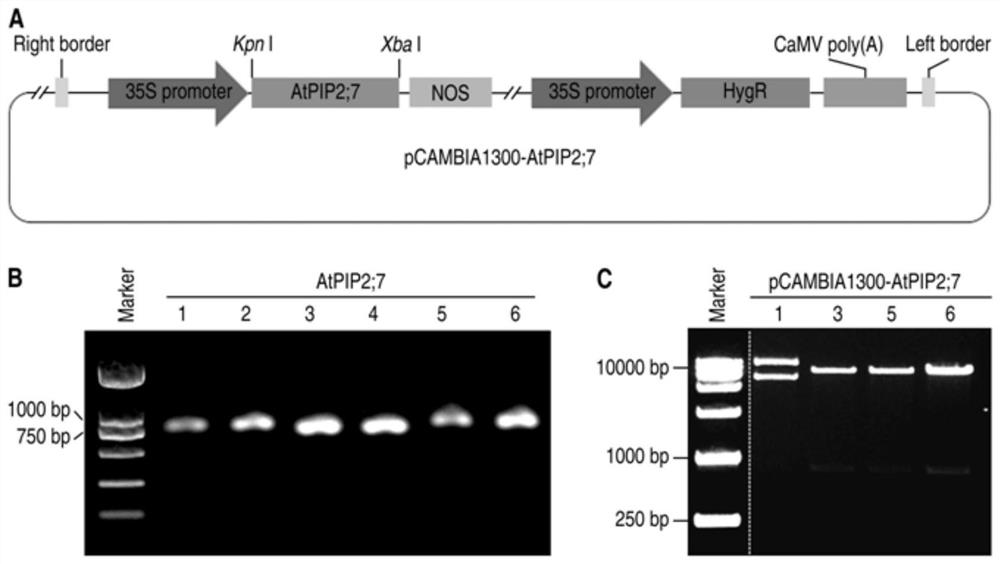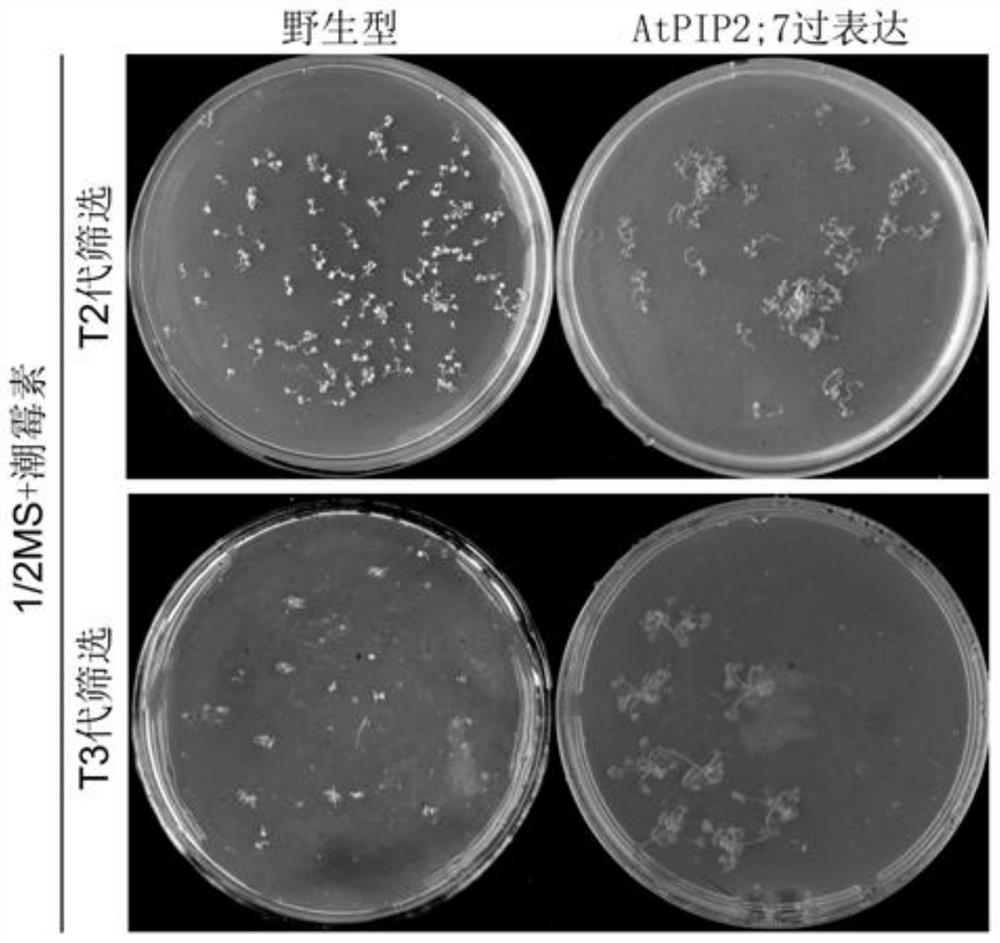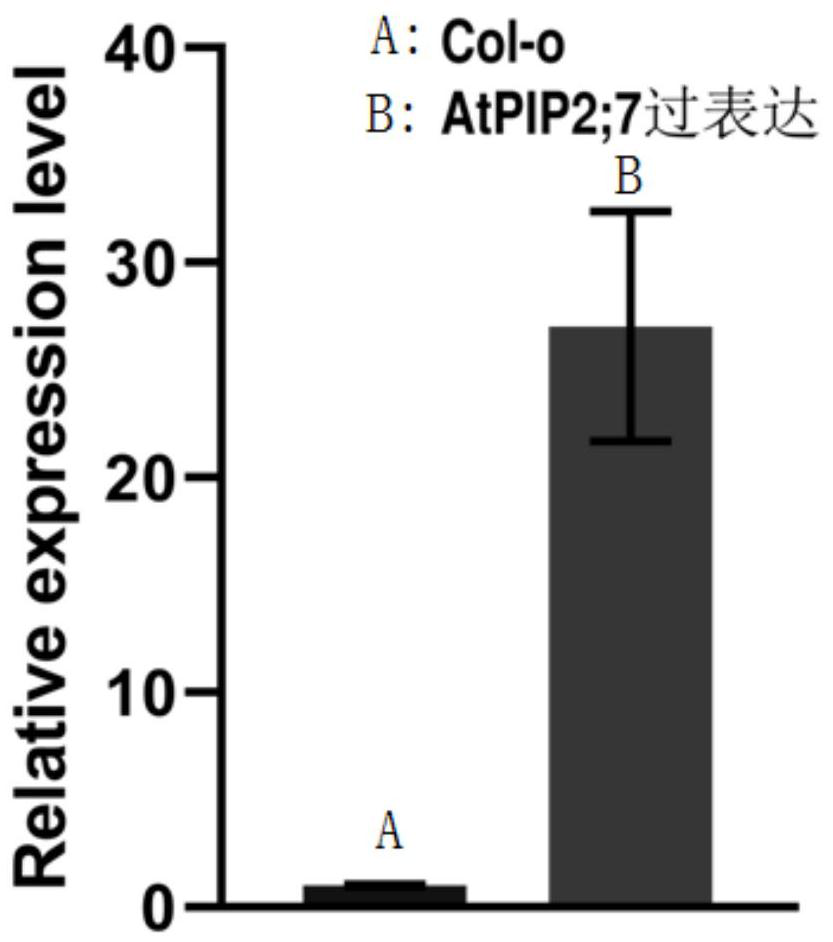A gene atpip2 for improving plant disease resistance; 7 and its application
A disease resistance and plant technology, applied in the field of plant molecular biology and plant genetic engineering, can solve the problem of unpredictability of function and achieve the effect of improving disease resistance and promoting plant growth
- Summary
- Abstract
- Description
- Claims
- Application Information
AI Technical Summary
Problems solved by technology
Method used
Image
Examples
Embodiment 1
[0067] Embodiment 1: AtPIP2; Construction of 7 overexpression vector
[0068] Extract Arabidopsis thaliana Col-0 ecotype RNA, and reverse transcribe it into cDNA. Use PrimerSTAR Max DNA polymerase (Takara), use the cDNA obtained above as a template, and use the sequences in Table 1 as primers to amplify Kpn I and Xba I two restriction sites of AtPIP2; 7 gene. The amplification program was as follows: 98°C, 5 minutes; 98°C, 30 seconds, 60°C, 30 seconds, 72°C, 30 seconds, 30 cycles; 72°C, 10 minutes. The amplified 6 tubes of DNA products (respectively numbered 1-6) were detected by gel electrophoresis ( figure 1 B).
[0069] The amplified product was purified and digested with two restriction endonucleases Kpn I and Xba I, and then purified again to obtain a gene fragment with cohesive ends at both ends. At the same time, the vector pCAMBIA1300 used for plant overexpression was prepared, and after being digested with two restriction enzymes Kpn I and Xba I, the linearized vec...
Embodiment 2
[0072] Embodiment 2: pCAMBIA1300::AtPIP2; Transgenic operation and overexpression strain screening of 7
[0073] With pCAMBIA1300::AtPIP2; 7 plasmids (prepared in Example 1) are transformed into Agrobacterium EHA105 competent, and positive clones are taken in 20 mL of YEB liquid medium containing 50 μg / ml rifampicin and 50 μg / ml kanamycin, 28 Cultivate overnight at 220 rpm. Take 5 mL of the culture, transfer it to 100 mL of new liquid YEB medium containing 50 μg / ml rifampicin and 50 μg / ml kanamycin, and incubate at 28°C and 220 rpm for 12 hours. Collect the cells by centrifugation at 10000xg for 5 minutes at 4°C. Use 1 / 2 MS to wash the cells, and collect the cells by centrifugation at 10000xg for 5 minutes at 4°C. Use 1 / 2MS to resuspend the bacteria and adjust the OD of the bacteria suspension 600 to 0.8, add 3 / 10,000 surfactant Silwet L-77, and place the obtained bacterial suspension on ice for use.
[0074] After Arabidopsis bolting, Agrobacterium-mediated transgenesis was...
Embodiment 3
[0076] Example 3: Analysis of the expression level of the overexpression strain AtPIP2; 7
[0077] The wild type and AtPIP2;7 overexpressed Arabidopsis thaliana grown under short-day conditions for 4 weeks were selected, the aerial part was quickly cut and placed in liquid nitrogen, and the Arabidopsis tissue was ground into powder in liquid nitrogen, and the powder was placed in the into a 2.0 ml eppendorf tube containing 1 ml Trizol (purchased from Invitrogen). After the plant tissue was completely crushed, the plant tissue RNA was extracted by phenol-chloroform extraction. After reverse transcription into cDNA, it was stored in a -20°C refrigerator until use.
[0078] Using the above cDNA as a template, the primers in Table 2 and ChamQ Universal SYBR qPCR MasterMix (purchased by Novizyme) were used to carry out a fluorescent quantitative PCR test. The fluorescent quantitative PCR program is as follows: 95°C, 30 seconds; 95°C, 3 seconds; 60°C, 10 seconds; a total of 40 cyc...
PUM
| Property | Measurement | Unit |
|---|---|---|
| molecular weight | aaaaa | aaaaa |
Abstract
Description
Claims
Application Information
 Login to view more
Login to view more - R&D Engineer
- R&D Manager
- IP Professional
- Industry Leading Data Capabilities
- Powerful AI technology
- Patent DNA Extraction
Browse by: Latest US Patents, China's latest patents, Technical Efficacy Thesaurus, Application Domain, Technology Topic.
© 2024 PatSnap. All rights reserved.Legal|Privacy policy|Modern Slavery Act Transparency Statement|Sitemap



